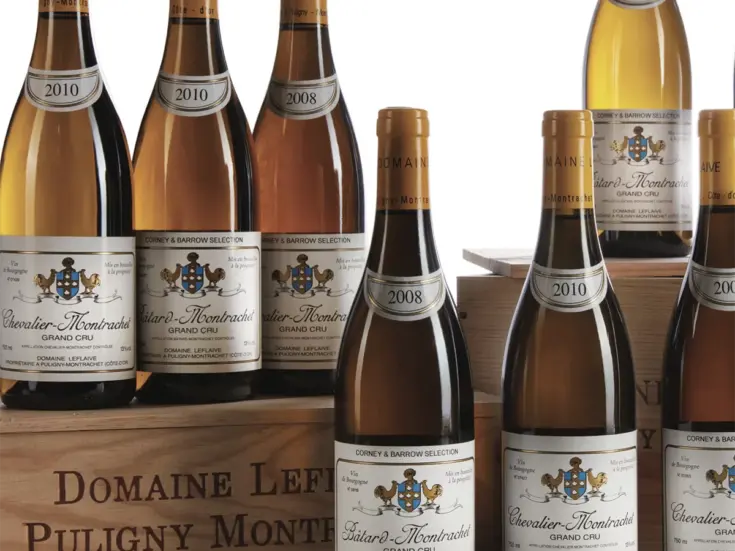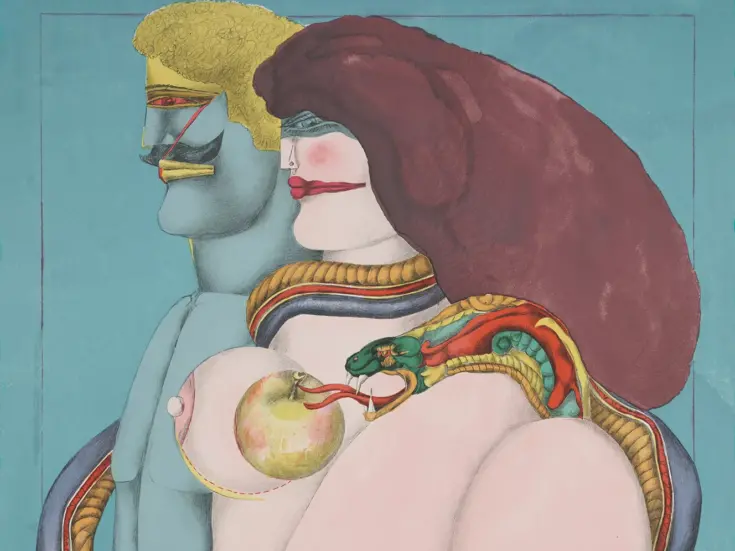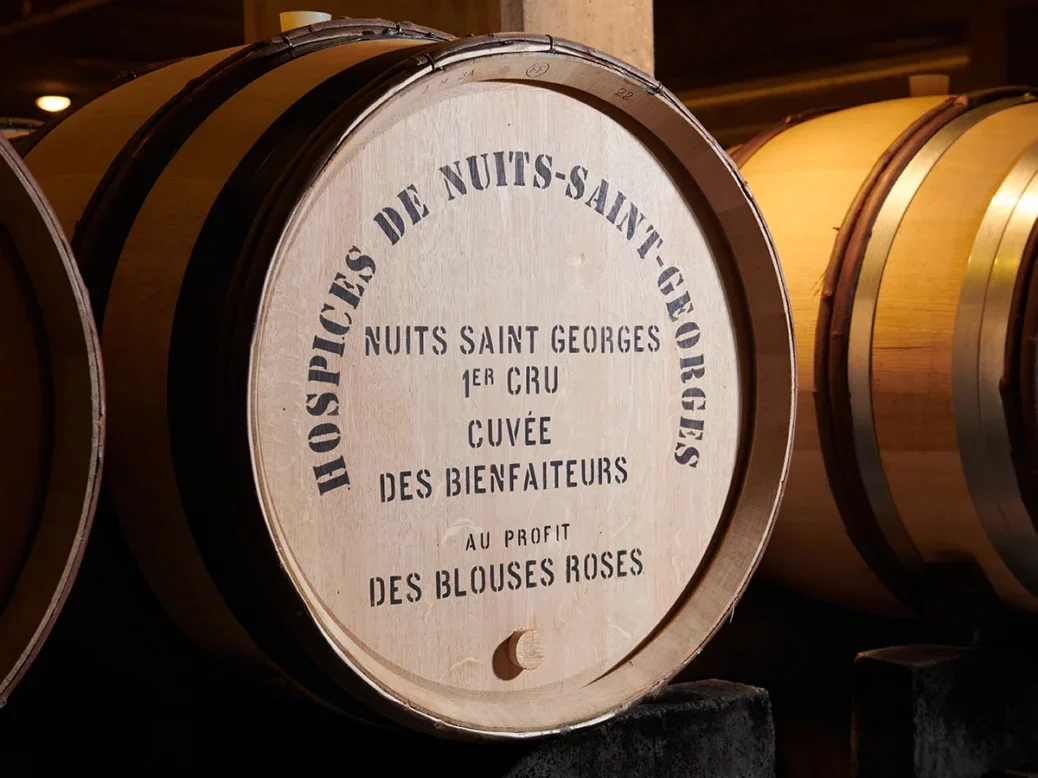
Once overshadowed by the glitzy, world-renowned Hospices de Beaune event, the Hospices de Nuits-St-Georges auction has been transformed in recent years, while retaining its more discreet charm, says Sarah Marsh MW, who reports from the latest, highly successful edition.
The small crowd that had gathered outside the Château du Clos de Vougeot hummed with anticipation. Subtle excitement was brewing before the 62nd Hospices de Nuits-St-Georges wine auction.
This auction has lurked in the shadows, relatively unknown, but over the past four years has been transformed thanks to a collaborative drive to refresh the event and raise its profile. Hugues Cortot, a switched-on young auctioneer from Dijon, has been on a mission to energize and modernize the rather dusty, old-fashioned proceedings. VitaBella, the luxury wine marketer, has marshaled the press and sprinkled the event with its magical brand of stardust. And the négociants of Nuits-St-Georges have spread the word among their customers.
On the second Sunday in March, I joined the négociants, hopeful private bidders, and some fellow members of the media for the auction of the 2022 vintage, following a barrel-tasting in the cellar of the Hospices de Nuits. Outside the Château du Clos de Vougeot I had a quick word with négociant Albéric Bichot. Although there is little crossover of négociants bidding at the two Hospices auctions, Bichot is the largest bidder at both, shelling out a cool €5.1 million at the Beaune auction last November. He felt that the prices of that auction were “about stable” with the 2021 vintage, although both vintages, 2021 and 2022, sold for double that of 2020. The exception was the record-breaking 2022 Bâtard-Montrachet, for which Bichot paid €300,000 and bought three of the five pièces. Was he hoping for more reasonable prices at the Hospices de Nuits wine auction? “Umm, yes,” he smiled ruefully, “but the proceeds do go to charity, so maybe not too much.”
The funds raised by the Hospices de Nuits-St-Georges wine auction have helped reconstruct the hospital serving the residents of Nuits-St-Georges. François Poher, Auction Director for both Hospices, explains that the fundamental objective is to offer an extra level of care above that of a purely state-run local hospital. All patients have their own room, which is all the more important because the hospital accommodates the very elderly.
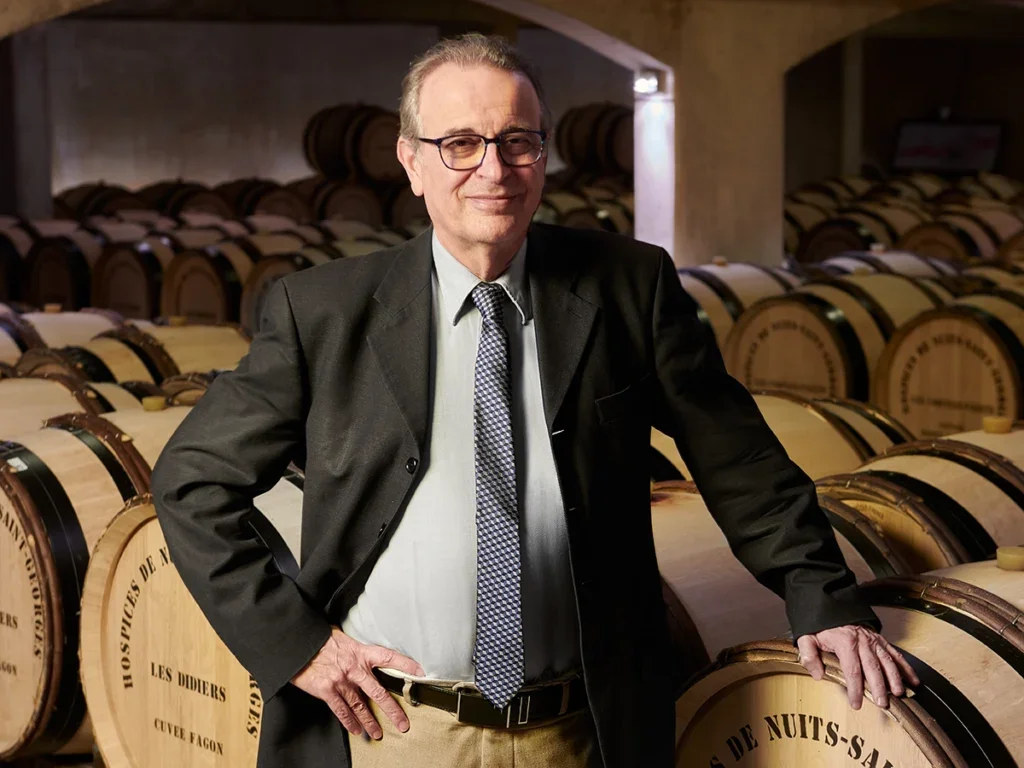
Hospices de Nuits-St-Georges: A long, turbulent history
The history of the Hospices de Nuits dates from 1270, long before the Hospices de Beaune was founded in 1443. Together with the Léproserie de Meursault, it was an hospices that received people suffering from leprosy. In Meursault, the Romanesque building survives, and after years of neglect was renovated relatively recently, but sadly the medieval Hospices de Nuits was destroyed during the French Wars of Religion (1562–98). The archives went up in flames, hence there is scant information about how the Hospices de Nuits was supported from the 13th century to the 17th, beyond the supposition that it survived on private donations and drew revenue from endowments of forest and sheep.
The first recorded gift of vineyards in the 17th century was made in 1688 by Huges Perdrizet, and the last, about 15 years ago, was a substantial village parcel of Gevrey-Chambertin Les Champs Chenys (yielding 12 barrels in 2022), which increased the area of the domaine to a total 12.7ha (31 acres). Apart from the Gevrey parcel, the vineyards are all in Nuits-St-Georges, where the hospices owns parcels in nine of the 41 premiers crus. The early history of the domaine is hazy, as to whether it sold grapes or wine, but by the early-20th century, its wine was sold in bulk to the local négociants. Edouard Delaunay, a significant négociant of the time, was then the largest buyer, scooping up around one third of the Hospices’ production. The first auction took place in 1961, exclusively for the négociants of Nuits-St-Georges. When the Delaunay family sold their business to Boisset, the fortunes of the auction dwindled.
Meanwhile, the Hospices de Beaune auction, which stole a march of a hundred years, grew swiftly, attracting global recognition and, more recently, notoriety for record prices. With a wealthy international client base generated by Christie’s and now, over the past two years, by Sotheby’s, it’s not surprising that its razzmatazz has rather eclipsed the comparatively understated auction in Nuits-St-Georges.
When Laurent Delaunay emerged on the Burgundy wine scene in 2017, however, having bought back the family name and achieved notable success with his first vintage as a newly minted négociant, he was determined to carry the fortunes of the Hospices de Nuits-St-Georges wine auction forward in his wake.
Delaunay comments, “The Hospices de Nuits auction, which was a local B2B event, was always overshadowed by the Hospices de Beaune auction. But the change in auctioneer has changed its appearance. Hugues Cortot is younger and more professional. And the media are more present.” In 2020, Delaunay insisted that the auction should be broadcast live for the first time. “Lots of Nuits-St-Georges négociants are participating in improving the reputation of the auction… Thibault-Liger-Belair, Faiveley, and Boisset.” This makes sense, as it draws more attention to Nuits-St-Georges wines in general. “Over the past four years, the attendance and interest have grown, and this is reflected in rising prices.”
I can’t envisage this auction ever competing with the glamor and global noise generated by the Hospices de Beaune auction. But that’s a good thing. The Hospices de Nuits has far fewer vineyards than the expansive 60ha (150 acres) of the Hospices de Beaune, which spread across the Côte d’Or, down to the Mâconnais and now up to Chablis, with the donation of a parcel of premier cru Côte de Léchet from Jean-Marc Brocard.
The Hospices de Nuits-St-Georges auction certainly shouldn’t be considered a “lesser” auction, merely smaller and more focused. Its future lies in establishing a discreet cachet of its own.
In 2019, when decisions were being made on how to reinvent it, François Poher, as director of both auctions, deliberately chose not to ask Sotheby’s or Christie’s, but appointed a local auction house, Cortot et Associés based in Dijon, instead. He was impressed with Hugues Cortot’s enthusiasm and vision. Cortot comments, “I wanted to change, refresh, and update the auction, and the first thing that had to go was the candles.” As at the Hospices de Beaune until 20 or so years ago, a candle was burned for each lot, and the last bid before it went out secured the lot. “It was boring and took so long, with the auctions finishing late in the evening.” Now the pace is much more vigorous… especially when the auctioneer can jumps lots. (The bidder who secures the first barrel in each lot has the right to buy the remaining barrels at the same price.)
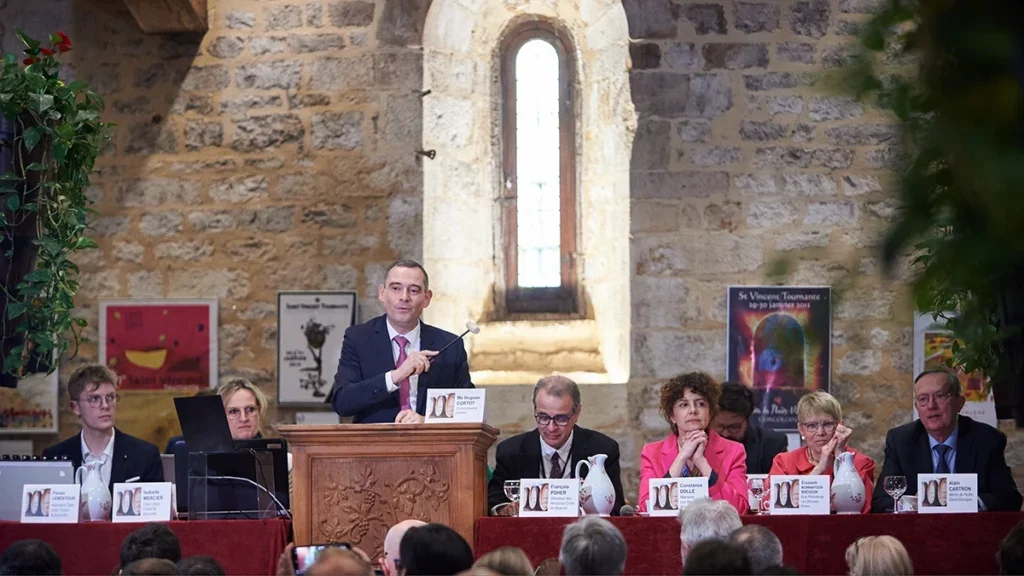
Another significant change is the inclusion of private individuals in the sale. Anyone can now register with Cortot et Associés to bid, but the wine must be matured by a négociant in Burgundy and cannot be removed until after bottling. It’s advisable to arrange this in advance, as the Domaine des Hospices de Nuits requires the buyer to provide this information within a couple of weeks of the sale, even though barrels don’t have to be moved until July 1. Cortot publishes a list of négociants and some, like Delaunay, will customize bottles with the buyer’s name, but any willing négociant can mature the wine.
A friendly, more egalitarian affair
As for the auction itself, it could be quite intimidating to bid at the Hospices de Beaune, but the Hospices de Nuits auction is a more intimate, low-key, and friendly affair. Nevertheless, most private individuals ask a négociant to bid on their behalf, which can benefit both parties. All the wine is aged in new oak barrels, divided equally between François Frères, Taransaud, and Damy. After four or five months spent in barrel, the wine will certainly be influenced by the different cooperage. The wine can be moved into different barrels, before or after more aging, but where there is more than one barrel, it could be blended with other barrels of the same wine. I had a chat with Thibault Liger-Belair while tasting in the Hospices’ cellar. “I try to purchase two or, better still, three barrels of any cuvée to create a good balance,” says Liger-Belair, “I bought three barrels of Les St-Georges last year, which gave me more choice. With this, I can make a more sophisticated wine.”
The length and type of oak aging is a matter of discussion between the négociant and the buyer. It makes sense to be familiar with the négociant’s style, and the temperature and condition of their barrel-cellar. Liger-Belair, for example, prefers not to rack the wine, favoring a more reductive maturation. He remarked on the improved quality of the Hospices’ wine. “They used to be very oaky, with too much coconut and vanilla, with rustic and dusty tannins. I would move the wine immediately, but the oak is much better now.” Some may stay in the new barrel, while some may go to a more reductive second-fill barrel. “With the vinification of the Hospices, I would keep them for at least 20 months,” he adds.
The 2022 vintage was an early and ripe vintage. “Key to 2022 is keeping the freshness, and a fine-grained barrel can help,” says Liger-Belair, “I see the palate as broad, and I need to stretch the attractive upfront fruit into a long finish.”
Private individuals have been allowed to bid since the 2020 auction, but because most use a négociant, it’s not easy for Cortot and Poher to gauge where the market is expanding. They are trying to attract the American and Asian markets, but Delaunay comments that his private buyers are mainly European. There was, however, a noticeable Chinese presence over this auction weekend.
I had exchanged a few words with a Chinese gentleman during the tasting, after he approached me, curious to know what I would be bidding on. He told me he was a regular at the Hospices de Beaune auction, where he purchased three barrels of 2022, “for a good price, during a lull in the bidding.” He was sure the Hospices de Nuits auction is now attracting buyers from its more glamorous counterpart, and later, Albéric Bichot also alluded to a growing interest from his customers. Albert Bichot went on to be the largest buyer (as it has long been at the Hospices de Beaune auction), acquiring 36 barrels for a total of €1,072,500, representing 30 percent of the total value. Albéric Bichot said after the auction, “The reputation of the sale continues to grow year after year, thanks to the excellent work done by the Hospices winemaker Jean-Marc Moron. Buyers were seduced by the very high quality of the 2022 vintage, a sunny and opulent vintage, perfectly balanced and with a nice freshness.”
Giving and sharing in Nuits-St-Georges
I spent the weekend with a small group, among whom were a couple of French lawyers attending the auction for a third year to bid on a barrel of Nuits-St-Georges Cuvée Claude Poyen. Not a bad choice. This cuvée is a blend of Les Saints-Juliens and Les Plateaux, and will certainly appeal to Nuits fans, for it is the most structured of the four village cuvées.
These wine-loving lawyers settled in to enjoy a relaxed weekend, hoping to have a barrel to mature, and the 288 bottles will eventually be split among three friends. Their relaxed approach, the understated feel of the event, and the easy mix of private and professional people now embody the positive spirit of this auction.
The spirit of inclusiveness is also reflected in the subscription sale of the charity pièce (the Cuvée des Bienfaiteurs). This is another innovation. Anyone may apply to buy a bottle from this barrel for €150. Rather than auctioning a charity barrel, this approach offers a more affordable way for more people to support a charity, which changes annually. This year, the proceeds (€64,580) will go to Les Blouses Roses, a national association of volunteer visitors to hospital and retirement homes. The money will fund animal and music therapy for disabled children.
Previously, a stand-out barrel was selected to be the charity piéce, but this has also been changed. Now a special cuvée is made, combining the nine Nuits-St-Georges premiers crus. I wondered how the 660lb (300kg) cuvée had been managed, since it is made from parcels across the appellation, which would ripen at different times. Jean-Marc Moron, winemaker for the Hospices, explains that specific vines in each premier cru are identified and harvested separately. He admitted that this requires some juggling. Les St-Georges and Les Didiers were picked riper than the surrounding vines, while others were picked slightly less ripe. Everything at the domaine is destemmed, and Moron prefers to use pigeage during the fermentation, remontage pre and post. I cannot comment on the result, as it was not in the tasting I attended.
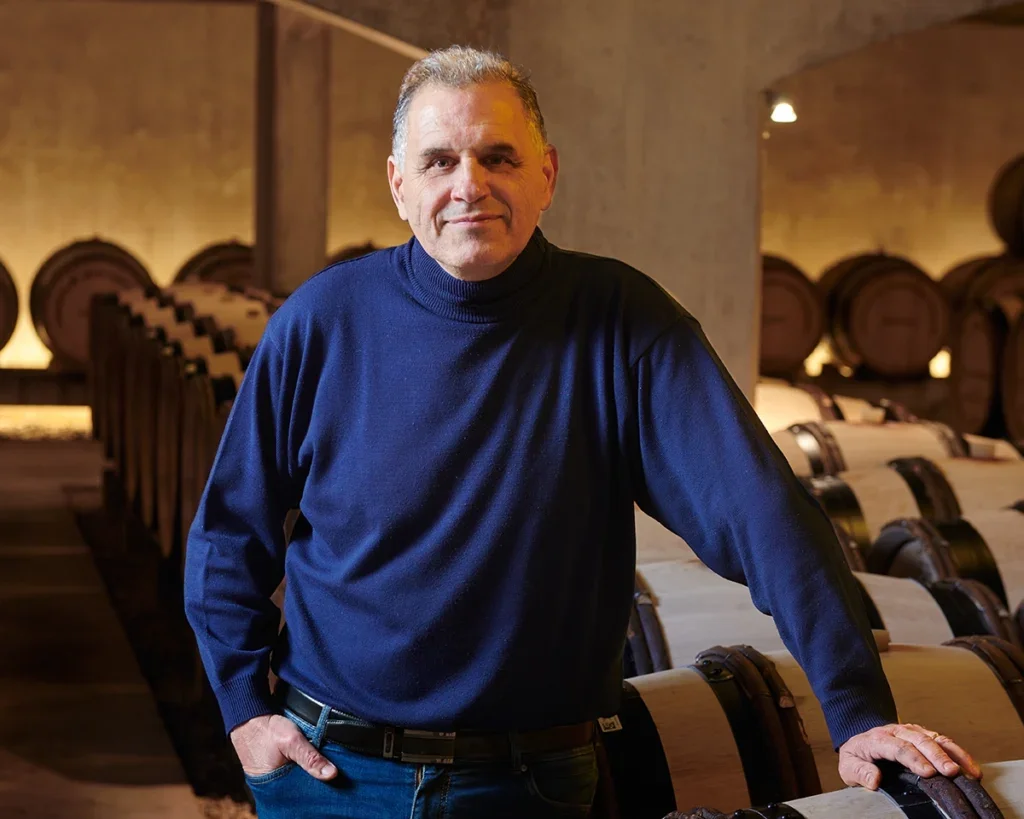
I did, however, taste everything else. The samples on offer were a blend of all the barrels of the cuvée across the three coopers. This tasting captures a moment in time in March, which is early in the maturation process, after which the wines will continue to evolve. Bear in mind that once barrels of the same wine leave this cellar, they will develop in quite different directions.
There is one white wine from the premier cru Les Terres Blanches, from a parcel at the top of the slope, across the border in Premeaux, together with Les Didiers and Corvées Paget.
Still a gem
At the pre-auction lunch in the Château du Clos de Vougeot I bumped into Jérôme Flous, who manages both the vineyards and the winemaking at Faiveley. Faiveley purchased one barrel of 2021 Les St-Georges Cuvée Georges Faiveley last year and Flous was preparing to bid for a barrel of the 2022.
As we sat down for lunch, Cortot expressed a keen interest to meet Flous, which prompted a swift introduction before the auction. “I hope to encourage Faiveley to buy more barrels,” he told me. Clearly Cortot doesn’t have the client pull of the prestigious international auction houses, but he is local, very likeable, and intent on forging connections with the négociants and, by extension, their network of customers; something he considers to be a year-round project, rather than a swift swoop to conduct the auction. The strategy seems to be working. The négoce were out in force, bidding for themselves as well as for their clients.
Faiveley went on to purchase two barrels of Les St-Georges Cuvée Faiveley for €55,000 a barrel, an increase on the €52,000 paid last year. The three barrels of 2022 Les Terres Blanches Cuvée de Pême raised €99,000, a touch less per barrel than last year, but there was just one barrel of the 2021. The average price for the 18 cuvées of red wine was €22,318, also a smidgen (0.73%) below last year.
I can’t help feeling relieved that the prices were stable, given the escalation in recent years, particularly for the scarce 2021s. I am delighted, however, that the sum raised for charity was record-breaking. The generous 2022 vintage produced 160 barrels, far more than the 109 barrels of 2021, which generated €3,504,000 in total sales, a substantial increase of 44.32% over last year.

At the tasting, Laurent Delaunay described the Hospices de Nuits-St-Georges wine auction as a “hidden gem.” I first attended the auction in 2020, when that stone had been freshly cut. Since then, it’s clearly been polished. Hidden? Not any more. But nor is it yet a “must-attend” fixture in the Burgundy calendar. It’s not a glamorous event, exclusive by virtue of sky-high prices. But that’s part of its attraction, which lies rather in its discreet, focused, and, at least for now, more affordable profile, and it’s open to everyone in the know.
The tasting
The auction prices realized per barrel are given in brackets (without commission and TVA).
White
Nuits-St-Georges Premier Cru Blanc Les Terres Blanches Cuvée Pierre de Pêmes
Sappy, stony white, slightly austere, the grip balanced with good concentration of fruit. I like the energy and the almondy bitterness and salinity on the finish. I hope this will not stay in new oak. (€32,000–34,000)
Red
There are five village cuvées. The Gevrey-Chambertin is a single parcel, while the Nuits-St-Georges wines are blends. Two stood out.
Nuits-St-Georges Cuvée Guillaume Labye
This is a blend of Lavières and Bas de Combe. Engagingly fruity and forward. Smoothly textured and fluid, it flows gently into a lightly salty finish. It has plenty of charm and combines sweetness with some elegance. (€15,000)
Nuits-St-Georges Cuvée Claude Poyen
A blend of Saint-Julien and Plateaux. Juicy succulence on the front palate, this is rich and firmly structured, with some breadth mid-palate. Thick, chamois-leather tannins. An assured finish for a village wine. Quite punchy. It will need more time than the Lavières blend. (€14,000–15,000)
Now for the nine premiers crus. There were 13 red wines in the auction, as premiers crus Les Didiers and Les St-Georges are each divided into three separate cuvées. Those I liked least were the premiers crus Vignerondes (swamped by oak) and Rue de Chaux (baked fruit and pretty tough).
I quite liked the following group, which all showed some terroir definition.
Nuits-St-Georges Premier Cru Les Boudots Cuvée Mesny de Boisseaux
Dark, ripe fruit aroma. Plump and generously rounded palate. Quite thickly textured chocolatey tannin, but it lacks some freshness and is a little one-dimensional. (€33,000–41,000)
Nuits-St-Georges Premier Cru Les Murgers Cuvée Guyard de Changey
Better balanced than the Boudots and more refined than Porrets. It’s juicy and energetic. A perfumed aroma and fullish, spicy palate, with a light, velvety texture. It’s just nicely fresh. (€25,000–26,000)
Nuits-St-Georges Premier Cru Les Porets Cuvée Antide Midan
A decent Porets. Lots of fruit, big-boned, broad, and generous; slightly chunky, but not too heavy. (€24,000–25,000)
The following two wines, both in Premeaux, are not better than the Murgers or the Porets, but I find them more stylish.
Nuits-St-Georges Premier Cru Les Terres Blanches Cuvée St-Bernard de Cîteaux
I like this lighter wine, but acknowledge that the finish is not as long as I would hope—nor, indeed, as long as some of the preceding premiers crus—but the fresh, angular, and salty style appeals. It has a high-toned perfume and slices lightly on the palate. Straight and piquant, with cranberry fruit and frosty minerality. It’s a touch edgy and has a light snap to finish. (€21,000–25,000)
Nuits-St-Georges Premier Cru Les Corvée Pagets Cuvée St-Laurent
Very Premeaux-Prissey. Smoothly silky, rippling tannins; quite finely textured. It glides across the palate, neatly woven with a light thread of freshness, which carries the finish. (€20,000–21,000)
And to finish, the premiers crus Les Didiers and Les Saint-Georges, although the younger-vine cuvées are not finer than some of the preceding wines. Les Didiers is a 6-acre (2.4ha) monopole, which abuts Les St-Georges on the north side and Domaine de l’Arlot’s Premier Cru Clos des Fôrets on the south, but seems quite unlike both. Jean-Marc Moron differentiates the terroir from the Hospices’ 2.5-acre (1ha) parcel of Les St-Georges, two thirds of which is deeper and flatter, while Les Didiers is shallower, has small stones, and two veins of limestone close the surface. It was planted in 1981 and 1950.
Nuits-St-Georges Premier Cru Les Didiers Cuvée Cabet
From forty-year-old vines. Bright, juicy, and fruit-driven. Engaging and lively, but quite straightforward after the previous wines. (€20,000–22,000)
Nuits-St-Georges Premier Cru Les Didiers Cuvée Jacques Duret
An equal blend of 40- and 70-year-old vines. Quite intense, this strikes a good balance between fresh and juicy fruit and a firmer, finer structure. More depth and layering. Quite elegant. Notably longer to finish than the young vines. (€18,000–24,000)
Nuits-St-Georges Premier Cru Les Didiers Cuvée Fagon
Named after Dr Guy-Crescent Fagon, a benefactor of the Hospices and a botanist who was Louis XIV’s Director of Gardens and a physician, promoting the health benefits of Burgundy over Champagne to the king. Very oak-dominated when I tried it first, so I went back to it the next morning. The morning of the auction was clear and sunny, and most of the wines showed better. Dark fruit, satin-smooth, dense, and compact. Savory and earthy, this has a vigorous finish. (€35,000–38,000)
Nuits-St-Georges Premier Cru Les St-Georges Cuvée des Sires de Vergy
From the younger vines, this is invitingly perfumed and floral. Creamy textured and supplely rounded, it is plentiful and exuberant. (€41,000–48,000)
Nuits-St-Georges Premier Cru Les St-Georges Cuvée Georges Faiveley
This cuvée was named in recognition of Georges Faiveley’s contribution to the local inhabitants during World War II. Made from the older vines, it is a quiet and composed wine. Rich, yet restrained, it shows immediate harmony and glides into a sleek and well-sustained finish. The finest and most sophisticated wine of the tasting. (€51,000–55,000)
Nuits-St-Georges Premier Cru Les St-Georges Cuvée Hugues Perdrizet
Another innovation, this new one-barrel cuvée is from a selection of the estate’s oldest vines, named after the Hospice’s first vineyard benefactor. I preferred the Cuvée Georges Faiveley. (€40,000)

